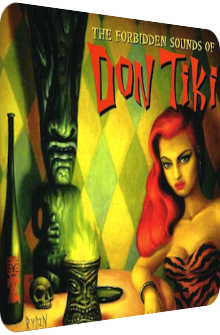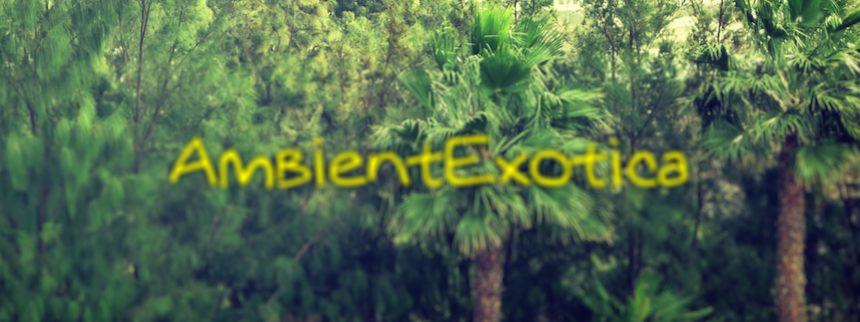
Don Tiki
The Forbidden Sounds
Of Don Tiki
1997
Don Tiki is the world-famous band that revived the Exotica genre on their own. While this assertion is historically problematic as there is never just one person or band who revives or invents genres and styles, the large and everchanging collective surely knew how to interpret the signs of the times. In the middle of the 90's when only a handful of people actively used the sparse source called the internet and its mailing lists, Kit Ebersbach and Lloyd Kandell came up with the Don Tiki project and tried to relive the glorious late 50's and early 60's.
The Forbidden Sounds Of Don Tiki established their style way before anyone else – with the possible exception of Combustible Edison's more Lounge-focused I, Swinger (1994) – and oscillates between jazzy, paradisiac, tropical and slightly Oriental songs, various instrumentals and three vocal tracks with lyrics, with only one song being a rendition. The album features many guest vocalists and is also famous for featuring two songs by the almighty Martin Denny written specifically for the album. It's worth an entry in the Guinness Book of World Records: not only did Denny invent and coin a whole new genre back in 1957, but after 40 years he also helped reviving the very genre he invented and which was virtually forgotten by the public of the 90's. Since then, many bands, compilations and collectors have surfaced the earth. The importance of the works of Don Tiki thus cannot be overstated. The pop art artwork by German artist Moritz R. is another indicator for the world-embracing, global approach of the Exotica movement that started in the U.S. but soon spread throughout the world, Atlantis and the Moon. Read more about the album that started it all again in 1997.
The approach of reinventing and reviving the Exotica genre by transporting it into the next millennium is already boldly perceptible on the first track Exotica ‘97, whose beginning features piano hooks that are suspiciously similar to Arthur Lyman‘s interpretation of Hugo Friedhofer's Vera Cruz. Considering the band‘s enormous knowledge about anything tiki-related and the writer of this piece being Martin Denny himself, it would be no surprise to me if this is a conscious reminiscence, if only for Lyman‘s famous first bird call performance as a member of Denny‘s band. And which song did the band play? Vera Cruz! While this sounds all good and well, the mystery behind Exotica '97 is even harder to grasp for outsiders or plain listeners as
Lloyd Kandell wrote me in an email: Denny and Don Tiki revisited an old tune Denny wrote in the late 50's called Exotica which is not on the album of the same name, but on his third album called Forbidden Island. Since this tune is transformed into a piano piece, Denny really came up with a gem for Don Tiki's first album. His cascading piano merges perfectly with Noel Okimoto‘s pristine vibraphones and Lopaka Colón‘s jungle sounds and bird noises. This is a majestic song that would have been a perfect closer as its dusky evening setup is perfectly suitable. It is purposefully reduced, the majority of the available instruments isn‘t used here in order to create a lush, faithful reproduction of 50‘s Exotica.
An Occasional Man follows, and it is highly melodious and joyful with its laidback Cha Cha Cha groove and Don Tiki satellite member Hai Jung Aholelei – her bright and beguiling voice is as capable in Crime themes as it is on this song with its gorgeous paradisical flute that is in constant interplay with Aholelei and underlines her lyrics. The backing choir and the tone shifts are also worth mentioning, for they add plasticity to an already mellifluous song. Perry Coma‘s (Kit Ebersbach's alter ego) slightly cacophonous Organs round off this scintilla from paradise – tremendously catchy!
Up next is Barbi In Bali that starts rather gloomy with deep bass slaps and various bells. The snares and bongos set in shortly after, and the mood changes to sneaky with a distinct hoity-toity harpsichord-like synth, staccato marimbas and Jim Howard‘s Polynesian flute melodies. A killer is the drum intersection in the middle of the song – the echoey reverb sounds as refreshing as the female backing howls and vocals. While Hot Like Lava delivers an intricately hot-blooded Latin flavor to the table that is smoothened by a variety of quavering organs and backing synthesizer bursts plus additional flute melodies and Middle Eastern vibraphone droplets, Close Your Eyes is a faithful rendition of the 1933 song by Bernice Petkere with vocals by Teresa Bright on another slowed down groove. The instrumental trademark is yet constituted by the swinging, corpulent organ whose sustain pulsates and wanders throughout the song.
One of my favorite Don Tiki originals is featured on here as well: Maidenhair Fern shuttles gorgeously between uncertain exhilaration and a mellifluous oasis of relaxation. Sharene Lum‘s colorful harp strings enhance the calmness, while the cymbals and the sirene-like vocals are livelier ingredients. A huge song for sure – but the next one is even bigger! Terminal adds the iconic voice of Jimmy Borges to the exotic omnium gatherum of the album and puts him into a stark Oriental setting with cascading flutes. However, the atmosphere is always smooth and jazzy due to the dominant piano backings, silky harps and whirling marimbas. The first half of the song even features a glitzy Rock organ that is normally used to create tension, but here its effect adds mellowness to a predominantly jazzy theme with a pinch of Oriental flavor.
Another song worth mentioning is Clutch Cargo Cult with its distinctive melody that consists primarily of short staccato bursts on piano and mallet instruments. The polyphony of the piano chords conceals the purposeful primitivity of the setup, and in the middle section a sudden U-turn occurs that features gently played harps and vibraphones; it also offers the most exposed use of the organ.
Bam-Boozled is a totally drugged song that features yet again the magical and bewitching voice of Hai Jung Aholelei. A chorus effect is added to her voice that amplifies the enchantment, while gentle harp strings and sparkling vibraphone dots take care of the aural diorama of a dark bamboo forest. This is definitely the most curious song on the album. There are quite a few slower songs in the tracklist, but this one builds an atmosphere that is neither playful nor jazzy, but definitely enthralling and thus broadens the concept of the album. It is no foreign substance, but quite a contrast to every other song of Don Tiki‘s Forbidden Sounds, as the next song shows: Itchy Palms is a maracas-heavy, conga-driven, technicolored song of carefree idleness. The main melody couples vibraphone and flute while the refrain consists of a eclectic and vibrating organ. The iridescent xylophone loops are another bright element. This is without a doubt the most accessible song on the album which makes it outstanding after the very first listen.
Da T'ing He Grows is another remarkable song – and very close to my heart due to its approach: it features a field recording of birds plus a few samples of a dedicated gardener and is much more keen on creating a vista than a song with commonplace structural parts. Echoey claves are clicking in the background, and there is no perceptible strong melody; the whole setup seems to be improvised and very Ambient in nature since there are only dubby bass slaps but no upbeat percussion. What several people may point out as the weakest link in Don Tiki's offering is, at least in my book, the most interesting and best song. Sure, it is no crowd pleaser and won't work in dynamic live performances, but it is a beautiful and surprisingly long vignette that transports the tropical island feeling way better than their other songs. Utterly gorgeous because of its lush setting and its seemingly arbitrary and improvised pluckings. Once again, songs like these always confirm me in my opinion that Ambient and Exotica music share many features. The last song is another Martin Denny piece specifically written for this album.
Forever & Ever is presented in a similar vein than the first song, but here, Denny plays a piano solo. The Exotica factor is thus very low, for the song consists of a reduced majesty that is atypical for the genre. Even though the mighty Denny came up with this piece, I still find it out of place and very much prefer his Exotica '97.
Naturally, I tend to speak about this album in the most glowing terms, for without the album's existence, there would have probably been a delay in the revival of Exotica. The inclusion of Martin Denny is another glamourous benefit. However, even from an objective viewpoint, the album is highly melodious and features dozens of guest musicians, satellite members, musical styles and instruments. You can feel the ambition of the production. Surprisingly enough, even though there are so many instruments on this album, there is never the feeling of oversaturation or cheap gimmickry. In fact, if I had to pinpoint the trademark instrument of Don Tiki on this album, it would definitely be the organ, which is modulated and configurated differently on each track. And while the band uses a synthesizer every so often, it never lets the setup shift to electronic spheres; everything feels hand-made and real.
That The Forbidden Sounds Of Don Tiki consists of mostly original material is another bonus and quite a risk, for it would have been easier to feed both the new generation of listeners and the old extravagant circle of Exotica afficionados with well-known established classics. Don Tiki chose the imaginative and hard way by creating soothing and mellow songs that are F just plain fun to listen to – and the Ambient track Da T'ing He Grows is a welcome surprise to me and a winner that gives you access to its magic after several listening sessions. All albums by Don Tiki are wholeheartedly recommended by me, but this one is as stylistically successful as it historically important.
Exotica Review 048: Don Tiki – The Forbidden Sounds Of Don Tiki (1997). Originally published on Mar. 17, 2012 at AmbientExotica.com.
